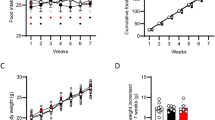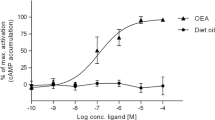Abstract
Gastric emptying regulates food intake. Oleoylethanolamide (OEA), an endogenous acylethanolamide chemically related to the endocannabinoid anandamide, inhibits food intake, but its effect on gastric emptying is unknown. Here, we investigated the effect and the role of OEA on gastric emptying in mice fed either a standard (STD) or a high-fat diet (HFD) for 14 weeks. Gastric emptying was reduced by OEA, but not by its saturated analog, palmitoylethanolamide. The effect of OEA was unaffected by rimonabant (cannabinoid CB1 receptor antagonist), SR144528 (cannabinoid CB2 receptor antagonist), 5′-iodoresiniferatoxin (transient receptor potential vanilloid type 1 antagonist), or MK886 (peroxisome proliferator-activated receptor-α) antagonist. Compared to STD mice, HFD mice showed delayed gastric emptying and higher levels of gastric OEA. HFD-induced increase in OEA levels was accompanied by increased expression of the OEA-synthesizing enzyme N-acyl-phosphatidylethanolamine-selective phospholipase D and decreased expression of the OEA-degrading enzyme fatty acid amide hydrolase. These results might suggest that elevation of gastric OEA could possibly contribute to the delayed gastric emptying observed in HFD-fed animals. HFD regulates OEA levels in the stomach through an increase of its biosynthesis and a decrease of its enzymatic degradation. The inhibitory effect of OEA on gastric emptying here observed might underlie part of the anorexic effects of this compound previously reported.





Similar content being viewed by others
Abbreviations
- AA-5-HT:
-
N-arachidonoylserotonin
- 2-AG:
-
2-arachidonoylglycerol
- DMSO:
-
Dimethylsulfoxide
- FAAH:
-
Fatty acid amide hydrolase
- HFD:
-
High-fat diet
- OEA:
-
Oleoylethanolamide
- I-RTX:
-
5′-iodoresiniferatoxin
- NAPE-PLD:
-
N-acyl-phosphatidylethanolamine-selective phospholipase D
- PEA:
-
Palmitoylethanolamide
- PPAR:
-
Peroxisome proliferator-activated receptor
- RT-PCR:
-
Reverse-transcription polymerase chain reaction
- TRPV1:
-
Transient receptor potential vanilloid type-1
- STD:
-
Standard diet
References
Lo Verme J, Gaetani S, Fu J, Oveisi F, Burton K, Piomelli D (2005) Regulation of food intake by oleoylethanolamide. Cell Mol Life Sci 62:708–716
Matias I, Gonthier MP, Petrosino S, Docimo L, Capasso R, Hoareau L, Monteleone P, Roche R, Izzo AA, Di Marzo V (2007) Role and regulation of acylethanolamides in energy balance: focus on adipocytes and beta-cells. Br J Pharmacol 152:676–690
O’Sullivan SE (2007) Cannabinoids go nuclear: evidence for activation of peroxisome proliferator-activated receptors. Br J Pharmacol 152:576–582
Proulx K, Cota D, Castaneda TR, Tschop MH, D’Alessio DA, Tso P, Woods SC, Seeley RJ (2005) Mechanisms of oleoylethanolamide-induced changes in feeding behavior and motor activity. Am J Physiol Regul Integr Comp Physiol 289:R729–R737
Rodriguez de Fonseca F, Navarro M, Gomez R, Escuredo L, Nava F, Fu J, Murillo-Rodriguez E, Giuffrida A, LoVerme J, Gaetani S, Kathuria S, Gall C, Piomelli D (2001) An anorexic lipid mediator regulated by feeding. Nature 414:209–212
Fu J, Gaetani S, Oveisi F, Lo Verme J, Serrano A, Rodriguez De Fonseca F, Rosengarth A, Luecke H, Di Giacomo B, Tarzia G, Piomelli D (2003) Oleylethanolamide regulates feeding and body weight through activation of the nuclear receptor PPAR-α. Nature 425:90–93
Gaetani S, Oveisi F, Piomelli D (2003) Modulation of meal pattern in the rat by the anorexic lipid mediator oleoylethanolamide. Neuropsychopharmacology 28:1311–1316
Guzman M, Lo Verme J, Fu J, Oveisi F, Blazquez C, Piomelli D (2004) Oleoylethanolamide stimulates lipolysis by activating the nuclear receptor peroxisome proliferator-activated receptor alpha (PPAR-alpha). J Biol Chem 279:27849–27854
Nielsen MJ, Petersen G, Astrup A, Hansen HS (2004) Food intake is inhibited by oral oleoylethanolamide. J Lipid Res 45:1027–1029
Fu J, Oveisi F, Gaetani S, Lin E, Piomelli D (2005) Oleoylethanolamide, an endogenous PPAR-alpha agonist, lowers body weight and hyperlipidemia in obese rats. Neuropharmacology 48:1147–1153
Movahed P, Jonsson BA, Birnir B, Wingstrand JA, Jorgensen TD, Ermund A, Sterner O, Zygmunt PM, Hogestatt ED (2005) Endogenous unsaturated C18 N-acylethanolamines are vanilloid receptor (TRPV1) agonists. J Biol Chem 280:38496–38504
Wang X, Miyares RL, Ahern GP (2005) Oleoylethanolamide excites vagal sensory neurones, induces visceral pain and reduces short-term food intake in mice via capsaicin receptor TRPV1. J Physiol 564:541–547
Petersen G, Sorensen C, Schmid PC, Artmann A, Tang-Christensen M, Hansen SH, Larsen PJ, Schmid HH, Hansen HS (2006) Intestinal levels of anandamide and oleoylethanolamide in food-deprived rats are regulated through their precursors. Biochim Biophys Acta 1761:143–150
Fu J, Astarita G, Gaetani S, Kim J, Cravatt BF, Mackie K, Piomelli D (2007) Food intake regulates oleoylethanolamide formation and degradation in the proximal small intestine. J Biol Chem 282:1518–1528
Yang Y, Chen M, Georgeson KE, Harmon CM (2007) Mechanism of oleoylethanolamide on fatty acid uptake in small intestine after food intake and body weight education. Am J Physiol Regul Integr Comp Physiol 292:R235–R241
Cuomo R, Sarnelli G (2004) Food intake and gastrointestinal motility. A complex interplay. Nutr Metab Cardiovasc Dis 14:173–179
Park MI, Camilleri M (2005) Gastric motor and sensory functions in obesity. Obes Res 13:491–500
Cummings DE, Overduin J (2007) Gastrointestinal regulation of food intake. J Clin Invest 117:13–23
Hellstrom PM, Naslund E (2001) Interactions between gastric emptying and satiety, with special reference to glucagon-like peptide-1. Physiol Behav 74:735–741
Serrano A, Del Arco I, Javier Pavon F, Macias M, Perez-Valero V, Rodriguez de Fonseca F (2008) The cannabinoid CB1 receptor antagonist SR141716A (Rimonabant) enhances the metabolic benefits of long-term treatment with oleoylethanolamide in Zucker rats. Neuropharmacology 54:226–234
Darmani NA, Izzo AA, Degenhardt B, Valenti M, Scaglione G, Capasso R, Sorrentini I, Di Marzo V (2005) Involvement of the cannabimimetic compound, N-palmitoyl-ethanolamine, in inflammatory and neuropathic conditions: review of the available pre-clinical data, and first human studies. Neuropharmacology 48:1154–1163
Capasso R, Matias I, Lutz B, Borrelli F, Capasso F, Marsicano G, Mascolo N, Petrosino S, Monory K, Valenti M, Di Marzo V, Izzo AA (2005) Fatty acid amide hydrolase controls mouse intestinal motility in vivo. Gastroenterology 129:941–951
Collino M, Aragno M, Mastrocola R, Benetti E, Gallicchio M, Dianzani C, Danni O, Thiemermann C, Fantozzi R (2006) Oxidative stress and inflammatory response evoked by transient cerebral ischemia/reperfusion: effects of the PPAR-alpha agonist WY14643. Free Radic Biol Med 41:579–589
Di Marzo V, Capasso R, Matias I, Aviello G, Petrosino S, Borrelli F, Orlando P, Capasso F, Izzo AA (2008) The role of endocannabinoids in the regulation of gastric emptying: alterations in mice fed a high fat diet. Br J Pharmacol Jan 28 [Epub ahead of print]
El-Salhy M (2001) Gastric emptying in an animal model of human diabetes type 1: relation to endocrine cells. Acta Diabetol 38:139–144
Bisogno T, Berrendero F, Ambrosino G, Cebeira M, Ramos JA, Fernandez-Ruiz JJ, Di Marzo V (1999) Brain regional distribution of endocannabinoids: implications for their biosynthesis and biological function. Biochem Biophys Res Commun 256:377–380
Izzo AA, Aviello G, Petrosino S, Orlando P, Marsicano G, Lutz B, Borrelli F, Capasso E, Nigam S, Capasso D, Di Marzo V (2008) Increased endocannabinoid levels reduce the development of precancerous lesions in the mouse colon. J Mol Med 86:89–98
D’Argenio G, Petrosino S, Gianfrani C, Valenti M, Scaglione G, Grandone I, Nigam S, Sorrentini I, Mazzarella G, Di Marzo V (2007) Overactivity of the intestinal endocannabinoid system in celiac disease and in methotrexate-treated rats. J Mol Med 85:523–530
Bisogno T, Melck D, De Petrocellis L, Bobrov MYu, Gretskaya NM, Bezuglov VV, Sitachitta N, Gerwick WH, Di Marzo V (1998) Arachidonoylserotonin and other novel inhibitors of fatty acid amide hydrolase. Biochem Biophys Res Commun 248:515–522
Suardiaz M, Estivill-Torrus G, Goicoechea C, Bilbao A, Rodriguez de Fonseca F (2007) Analgesic properties of oleoylethanolamide (OEA) in visceral and nflammatory pain. Pain 133:99–110
Ambrosini A, Zolese G, Ambrosi S, Ragni L, Tiano L, Littarru G, Bertoli E, Mantero F, Boscaro M, Balercia G (2006) Oleoylethanolamide protects human sperm cells from oxidation stress: studies on cases of idiopathic infertility. Biol Reprod 74: 659–665
Jonsson KO, Vandevoorde S, Lambert DM, Tiger G, Fowler CJ (2001) Effects of homologues and analogues of palmitoylethanolamide upon the inactivation of the endocannabinoid anandamide. Br J Pharmacol 133:1263–1275
Duncan M, Davison JS, Sharkey KA (2005) Review article: endocannabinoids and their receptors in the enteric nervous system. Aliment Pharmacol Ther 22:667–683
Massa F, Storr M, Lutz B (2005) The endocannabinoid system in the physiology and pathophysiology of the gastrointestinal tract. J Mol Med 83:944–954
Di Marzo V, Izzo AA (2006) Endocannabinoid overactivity and intestinal inflammation. Gut 55:1373–1376
Izzo AA (2007) The cannabinoid CB(2) receptor: a good friend in the gut. Neurogastroenterol Motil 19:704–708
Ahern GP (2003) Activation of TRPV1 by the satiety factor oleoylethanolamide. J Biol Chem 278:30429–30434
Holzer P (2004) TRPV1 and the gut: from a tasty receptor for a painful vanilloid to a key player in hyperalgesia. Eur J Pharmacol 500:231–241
Overton HA, Babbs AJ, Doel SM, Fyfe MC, Gardner LS, Griffin G, Jackson HC, Procter MJ, Rasamison CM, Tang-Christensen M, Widdowson PS, Williams GM, Reynet C (2006) Deorphanization of a G protein-coupled receptor for oleoylethanolamide and its use in the discovery of small-molecule hypophagic agents. Cell Metab 3:167–175
Wisen O, Hellstrom PM (1995) Gastrointestinal motility in obesity. J Intern Med 237:411–418
Asakawa A, Inui A, Ueno N, Makino S, Uemoto M, Fujino MA, Kasuga M (2003) Ob/ob mice as a model of delayed gastric emptying. J Diabetes Complications 17:27–28
Di Marzo V, Goparaju SK, Wang L, Liu J, Batkai S, Jarai Z, Fezza F, Miura GI, Palmiter RD, Sugiura T, Kunos G (2001) Leptin-regulated endocannabinoids are involved in maintaining food intake. Nature 410:822–825
Acknowledgements
This work was supported by Prin, Regione Campania, “Fondazione Enrico ed Enrica Sovena,” Epitech, S.r.l. (to SP and VDM), and Sanofi-Aventis (to VDM).
Competing interests
The authors declare no competing interests.
Author information
Authors and Affiliations
Corresponding authors
Rights and permissions
About this article
Cite this article
Aviello, G., Matias, I., Capasso, R. et al. Inhibitory effect of the anorexic compound oleoylethanolamide on gastric emptying in control and overweight mice. J Mol Med 86, 413–422 (2008). https://doi.org/10.1007/s00109-008-0305-7
Received:
Revised:
Accepted:
Published:
Issue Date:
DOI: https://doi.org/10.1007/s00109-008-0305-7




